Passengers 166 Fatalities 154 Date 20 August 2008 Survivor 18 | Crew 6 Injuries (non-fatal) 18 Number of deaths 154 Passenger count 166 | |
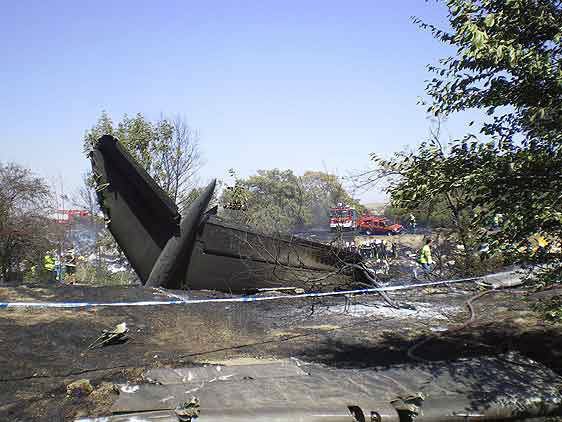 | ||
Summary Crashed during take-off due to improper flaps and slats selection Site Barajas Airport, Madrid, Spain Similar UPS Airlines Flight 6, Santa Bárbara Airlines Fl, FedEx Express Flight 80, United Express Flight 5925, XL Airways Germany Flight 888T | ||
Fs2004 fatal delay spanair flight 5022
Spanair Flight 5022 (JK5022) was a scheduled domestic passenger flight from Barcelona-El Prat Airport to Gran Canaria Airport, Spain, via Madrid Barajas Airport that crashed just after take-off from runway 36L at Madrid Airport at 14:24 CEST (12:24 UTC) on 20 August 2008. The aircraft was a McDonnell Douglas MD-82, registration EC-HFP. 154 people died; six died en route to hospital, one died overnight and one died in hospital three days later. Only 18 people survived.
Contents
- Fs2004 fatal delay spanair flight 5022
- Crash
- Fatalities
- Summary
- Fire or explosion
- Temperature sensor
- Thrust reverser
- Flaps and slats
- Flight mode
- Malware
- Final report
- Similar accidents
- References
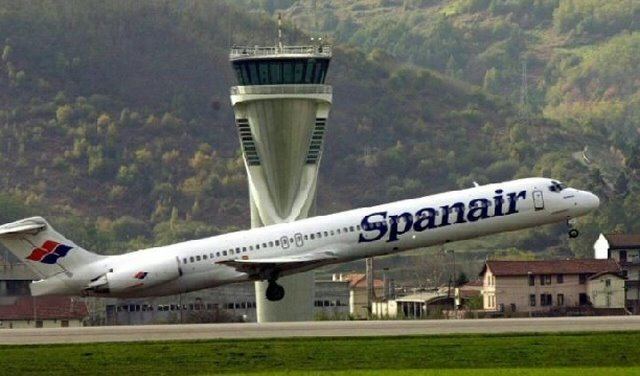
It was the only fatal accident for Spanair (part of the SAS Group) in the 25-year history of the company, and the 14th fatal accident and 24th hull loss involving MD-80 series aircraft. It was Spain's deadliest accident since the 1983 crash of Avianca Flight 011.
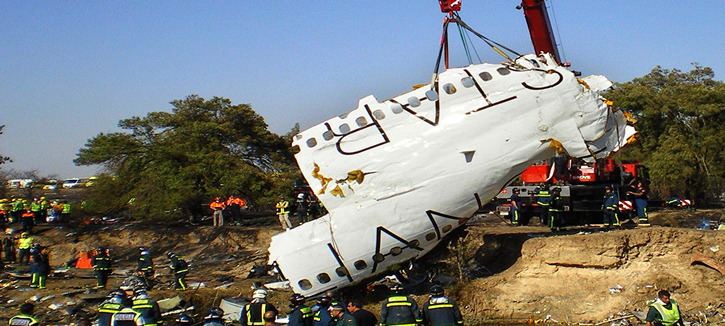
The accident further worsened Spanair's already negative image at the time, which was plagued by poor customer service, frequent breakdowns, and delays. The crash exacerbated financial difficulties at Spanair, which ceased operations on 27 January 2012.
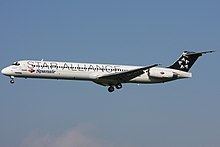
Crash
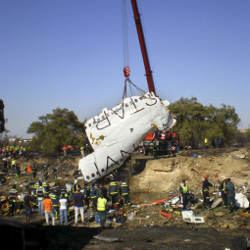
The aircraft, named Sunbreeze (registration EC-HFP; manufacturer's serial number 53148), had been acquired by Spanair in July 1999 and previously flown by Korean Airlines.
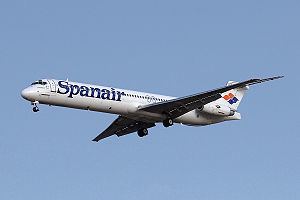
The flight was a Star Alliance codeshare (carrying passengers booked by multiple airlines), operated on behalf of Lufthansa as LH 2554. On board at takeoff were 166 passengers and six crew members. In charge of the flight was Captain Antonio Garcia Luna, 39. His first officer was Francisco Javier Mulet, 31.
The accident occurred as the aircraft attempted to take off, at 14:24 local time, due to the pilot's failure to deploy the flaps and slats as required for takeoff. Without the use of these "high-lift" devices, the wings could not generate enough lift to keep the aircraft airborne. The MD-80 has a warning system (the Take-off warning system or TOWS) that should have alerted the pilots that the plane was not correctly configured for take-off. However, the warning did not sound, and the pilots continued with the attempt. The aircraft left the ground momentarily, rolled to the right, and impacted the ground next to the runway. The wings separated from the aircraft and the fuselage broke into two main parts; the wings and the rear two-thirds of the fuselage were engulfed by fire.
This was the flight's second attempted take-off: over an hour earlier, the pilots had attempted and aborted a departure because a sensor reported excessive temperatures in an air intake; that sensor was de-activated on the ground (reportedly an established procedure, as that sensor was redundant for that flight). Another takeoff was then attempted, during which the accident occurred.
Fatalities
Of the 172 people on board, 146, including all crew members, perished in the crash or immediately after in the fire; of the 26 passengers rescued alive from the crash site, six died before arriving at hospital, and two more in hospital, bringing the total number of fatalities to 154.
135 of the deceased and 16 of the survivors were Spanish nationals; 19 of the deceased and 2 survivors were of other nationalities. The deceased included German, French, Mauritanian, Turkish, Bulgarian, Gambian, Italian, Indonesian and Brazilian citizens.
The crash flung some of the survivors into a stream, lessening the severity of their burns. A 30-year-old woman with British and Spanish dual citizenship survived with a punctured lung and broken left arm but no burns, as she was flung from row 6, still attached to her seat, into the stream.
Summary
The accident was investigated by the Civil Aviation Accident and Incident Investigation Commission (CIAIAC). Representatives from the US National Transportation Safety Board, the aircraft manufacturer Boeing (as successor to McDonnell Douglas, the original aircraft manufacturer), and the engine manufacturer Pratt and Whitney supported the investigation.
A preliminary report on the accident was released by CIAIAC on 6 October 2008. Flight data recorders showed that the aircraft had taken off with flaps at 0°, and that the alarm for that abnormal takeoff configuration had not sounded. The report hinted at no other cause of the accident. Both the engines and thrust reversers were excluded as causes of the accident.
On 17 August 2009, CIAIAC released an interim report on the incident. The interim report confirmed the preliminary report's conclusion that the crash was caused by an attempt to take off with the flaps and slats retracted, which constituted an improper configuration, and noted that safeguards that should have prevented the crash failed to do so. The cockpit recordings revealed that the pilots omitted the "set and check the flap/slat lever and lights" item in the After Start checklist. In the Takeoff Imminent verification checklist the copilot had simply repeated the correct flap and slat position values without actually checking them, as shown by the physical evidence. All three safety barriers provided to avoid the takeoff in an inappropriate configuration were defeated: the configuration checklist, the confirm and verify checklist, and the Take-off Warning System (TOWS). The report also made a number of safety recommendations intended to prevent incidents like this from happening again.
CIAIAC published a further progress note in August 2010, and its final report in July 2011.
Fire or explosion
Some early eye-witness accounts suggested that the aircraft suffered an engine fire or explosion before crashing, but the Spanish airport authority AENA released a video showing that the engines neither exploded nor caught fire during take-off. Manuel Bautista, Director General of Spain's civil aviation authority, went as far as to state: "The engine is not the cause of the accident", surmising that a chain of events combining together was more likely than a single cause.
Temperature sensor
There has been considerable interest in the faulty air temperature probe (the total air temperature sensor, located on the front of the aircraft near the cockpit) that initially caused the pilot to turn the plane back for maintenance before the second takeoff attempt. The mechanic simply deactivated the probe because the aircraft's Minimum Equipment List allowed it to be left inoperative. On 22 August investigators interviewed the mechanic, who defended his action by saying that it had nothing to do with the crash. Spanair has supported the mechanic's view that deactivation of the probe is an accepted procedure. On 1 September a report, quoting Spanair, stated that the problem detected on the first takeoff attempt was overheating caused by a temperature gauge's de-icing system, rather than a dysfunction of the temperature gauge itself, and that since icing was not a risk on that flight, the de-icing system had been deactivated by the mechanic with captain's approval.
On 11 May 2010, details from the cockpit voice recorder were leaked to the public and released by Spanish media. The recording showed that both pilots were concerned about a repair job performed earlier on the day of the crash, in which mechanics used an ice pack to cool an overheating temperature sensor and removed a fuse. The BBC reported that the judge investigating the crash was to question three mechanics on suspicion of manslaughter. These were the two mechanics who checked the plane before take-off and the head of maintenance for Spanair at Barajas.
Thrust reverser
One theory was that the thrust reverser of the No. 2 (right side) engine activated during the climb, since one of the thrust reversers was seen to be in the deployed position in the wreckage. The investigation concluded that the position of the thrust reverser was a result of the accident, not a cause of it. If the reverser deployed during takeoff, and not as a result of impact, it has been suggested that the plane would have yawed suddenly to the right. Aircraft engineer Alberto Garcia dismissed this suggestion, pointing out that the MD-82 has tail-mounted engines positioned close to each other and to the plane's longitudinal axis, so that any yaw from asymmetric thrust would be small. Thrust reversers are normally employed just after touch down to reduce braking distances. Examination of the aircraft's maintenance logs showed that the thrust reverser on the right-side engine had been deactivated pending repair. It had been wired shut, and tape placed over the cockpit control to alert the crew. The MD-82 is permitted to fly with just one operable thrust reverser.
Flaps and slats
El Mundo, citing a source in the investigation team, reported that the cockpit voice recorder showed that the pilot had said "Flaps OK, Slats OK" to the co-pilot. The article confirmed that the flaps had not been extended and that the alarm for that condition had not sounded. The final report concluded that the failure to deploy flaps was the cause of the accident. The warning signal that the flaps were not set failed to sound due to it sharing a common power source with the malfunctioning temperature probe that had its circuit breaker turned off.
The maintenance logbook of the airplane has comments, 2 days before the crash, for an "autoslats failure" visual alarm occurring on slats extension; however autoslats are not used on takeoff, and it cannot be inferred that the slats system had a defect.
Flight mode
In an article published on 7 September, El Mundo suggested that during the flight preparation and takeoff attempts, the aircraft had some of its systems in flight mode rather than ground mode. If true, this might explain why de-icing of the Total Air Temperature probe activated on the ground, causing overheating, since in flight the heater would activate only when there was no air flow in the probe, a sign of icing. This might also explain why the flaps and slats alarm had not sounded, since this alarm is disabled in flight mode.
James W. Hudspeth, an investigator of a previous near accident (an MD-83, starting from Lanzarote) that was similar in its details, pointed out that the fuse of the so-called "left ground control relay" at position K-33 of the control panel might have been the actual culprit in the erroneous flight mode: Hudspeth found out during a 2-week investigation at Lanzarote that it is customary in normal maintenance routine to temporarily remove this fuse to engage flight mode, but the fuse is afterwards sometimes not replaced correctly. Because of the frequent handling of this fuse, it is also not easy to visually check that the fuse is functioning properly (as is customary for the pilots to do when they enter the cockpit). Hudspeth speculates that this may have happened with both JK 5022 and Northwest Airlines Flight 255.
Malware
Spanish daily El Pais reported that, as revealed in an internal report issued by Spanair, malware which had infected their central computer system used to monitor technical problems with their aircraft may have resulted in a failure to raise an alarm over multiple problems with the plane. A judge ordered the airline to provide all the computer's logs from the days before and after the crash.
Final report
The CIAIAC published its final report into the accident on 26 July 2011.
It determined that the cause of the accident was:
The CIAIAC determined the following contributory factors:
Similar accidents
In the case of Northwest Airlines Flight 255, which happened 21 years earlier than flight 5022, also an MD-82, the crew had similarly been disrupted from routine operation before the fatal takeoff, and the alarm similarly had not sounded. In that accident, the reason for the lack of TOWS alarm was a tripped (or pulled) circuit breaker. However, examination of the alarm and its circuit breaker in flight 5022 had not revealed any fault.
